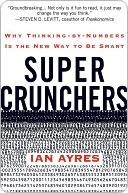More on this book
Community
Kindle Notes & Highlights
by
Ian Ayres
Read between
August 21 - August 24, 2019
“It is difficult to get a man to understand something when his salary depends on his not understanding it.”
One absolutely cannot tell, by watching, the difference between a .300 hitter and a .275 hitter. The difference is one hit every two weeks…. If you see both 15 games a year, there is a 40 percent chance that the .275 hitter will have more hits than the .300 hitter…. The difference between a good hitter and average hitter is simply not visible—it is a matter of record.
We are in a historic moment of horse-versus-locomotive competition, where intuitive and experiential expertise is losing out time and time again to number crunching.
What is Super Crunching? It is statistical analysis that impacts real-world decisions.
Wal-Mart had to apologize when people who searched for Martin Luther King: I Have a Dream were told they might also appreciate a Planet of the Apes DVD collection.
First, we found that if you made innocuous changes in Lott’s regression equation, the crime-reducing impacts of Lott’s laws often vanished.
More disturbingly, we found that Lott had made a computer mistake in creating some of his underlying data. For example, in many of his regressions, Lott tried to control for whether the crime took place in a particular region (say, the Northeast) in a particular year (say, 1988). But when we looked at his data, many of these variables were mistakenly set to zero.
When we estimated his formula on the corrected data, we again found that these laws were more likely ...
This highlight has been truncated due to consecutive passage length restrictions.
Nonetheless, it is disturbing that after Donohue and I pointed out the coding errors, Lott and his coauthors continued to rely on the flawed data.
There is no credible evidence that ‘right-to-carry’ laws, which allow qualified adults to carry concealed handguns, either decrease or increase violent crime.”


